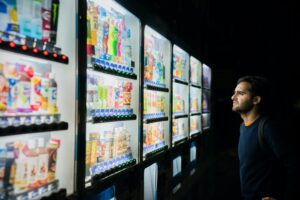
Whenever we go to Amazon, or Netflix, or any other site, we are immediately presented with dozens, if not hundreds, of choices. Many of these choices are randomly selected by the retailer based on past purchase behavior across the buyer’s digital mesh. Across multiple devices, the company knows our age, sex, and geographical location, and perhaps can algorithmically make some deterministic assumptions about what we like or don’t like.
But that has yet to translate into something that is presented to the customer as a reasonable choice set. It is no wonder that consumers feel bombarded by choice. They are simply overwhelmed.
We are presented, every day, in multiple contexts, with too many choices. We are presented with too many choices when we read digital publications. We are presented with too many choices when we look at the social media feeds of LinkedIn or Facebook. We are presented with too many choices when looking for a TV show or a movie. Humans are simply not capable of synthesizing hundreds, if not thousands, of choice alternatives when they are presented as a mass (mess?) of individual decisions. Our cognitive capability collapses under the weight of all of the choice decisions that must be made when presented with too much choice.
Companies generally, and advertisers and media assets in particular, have failed to make the leap from choice to curation. This is a huge opportunity for marketers in simplifying the marketing message, making the overall customer experience that much less burdensome and taxing, and draws the consumer closer to the value proposition that attracted the consumer in the first place.
As a general rule, consumers do not like other people making decisions for them. A good case in point is grocery shopping. Yet, in urban environments, direct delivery makes much more sense due to the many obstacles for grocery shopping in congested cities. A grocery shopper doesn’t have to fight city traffic, load up a car, drive to and from their apartment, or leave and subsequently enter parking garages to get the week’s groceries. One of my former clients, FreshDirect, learned early on that their business model wasn’t solely built around the ability to deliver high-quality produce at reasonable prices. The secret ingredient were their drivers. The drivers knew their customers at a personal level, and were able to create a curated experience by making sure that certain things were done to the customer’s exact specifications.
Why is curation so hard? E-commerce has not figured this out at all. Not long ago I ordered tires for my road bike from Amazon. On a subsequent login, Amazon suggested other road bike tires I might be interested in — for a product category purchased annually (at best). The lack of synchronization between recommendations, purchase frequency, and my likely need was stunningly dumb. Yes, Amazon is enormous, yes they make lots of money, but they still have not moved the needle on the concept of curation in any meaningful sense. What if Amazon had a viable competitor that really understood curation?
On the flipside, one of my favorite examples of curation is Spotify. Once again, one would think that Apple (iTunes) would have figured this out long ago, but Spotify is a wonder. If I want music for concentration, there is a curated playlist. If I want calming classical in the background, there is a curated playlist. Do they get it right all the time? No, but they are pretty close most of the time. And I don’t mind if they miss. AN 80% hit rate is pretty good to me. At least there are humans involved in the decision-making process. OK, yes, perhaps also an algorithm, but at least it is a collaborative effort.
Marketers would be well advised to start thinking about how to anticipate the kinds of products and services that customers will be looking for in a world where choice is overly abundant. Curation is one of the ways that marketers can demonstrate that they are tuned in to what customers are seeking, rather than blindly and programmatically jamming messages at them without any thought to the choice overload that they create. Does the marketer want to convey something meaningful, or add more noise? So far it has been the latter.
I hope that more marketing and advertising initiatives will consider the notion that humans are very, very good at intuiting what other humans might like or enjoy. The concept of curation can form a much-needed bridge between the antiseptic world of algorithmic decision-making and true human connection.
